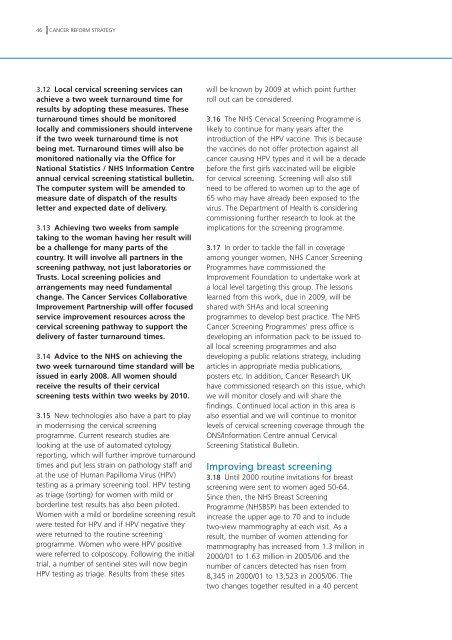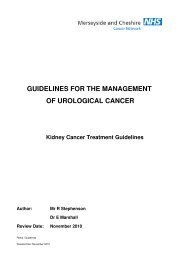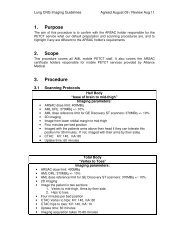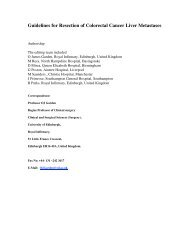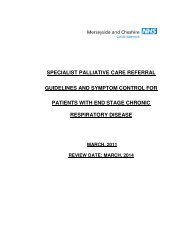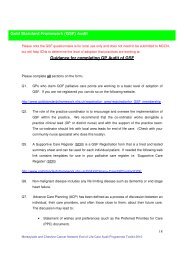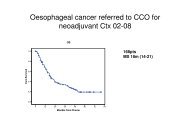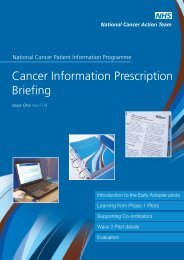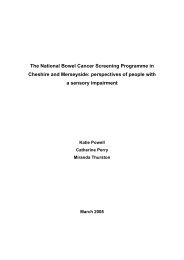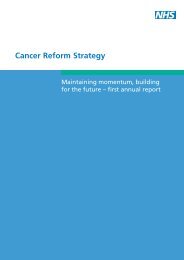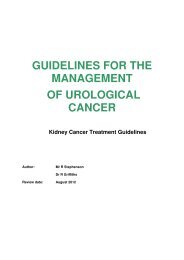Cancer Reform Strategy - NHS Cancer Screening Programmes
Cancer Reform Strategy - NHS Cancer Screening Programmes
Cancer Reform Strategy - NHS Cancer Screening Programmes
- No tags were found...
You also want an ePaper? Increase the reach of your titles
YUMPU automatically turns print PDFs into web optimized ePapers that Google loves.
46 CANCER REFORM STRATEGY3.12 Local cervical screening services canachieve a two week turnaround time forresults by adopting these measures. Theseturnaround times should be monitoredlocally and commissioners should interveneif the two week turnaround time is notbeing met. Turnaround times will also bemonitored nationally via the Office forNational Statistics / <strong>NHS</strong> Information Centreannual cervical screening statistical bulletin.The computer system will be amended tomeasure date of dispatch of the resultsletter and expected date of delivery.3.13 Achieving two weeks from sampletaking to the woman having her result willbe a challenge for many parts of thecountry. It will involve all partners in thescreening pathway, not just laboratories orTrusts. Local screening policies andarrangements may need fundamentalchange. The <strong>Cancer</strong> Services CollaborativeImprovement Partnership will offer focusedservice improvement resources across thecervical screening pathway to support thedelivery of faster turnaround times.3.14 Advice to the <strong>NHS</strong> on achieving thetwo week turnaround time standard will beissued in early 2008. All women shouldreceive the results of their cervicalscreening tests within two weeks by 2010.3.15 New technologies also have a part to playin modernising the cervical screeningprogramme. Current research studies arelooking at the use of automated cytologyreporting, which will further improve turnaroundtimes and put less strain on pathology staff andat the use of Human Papilloma Virus (HPV)testing as a primary screening tool. HPV testingas triage (sorting) for women with mild orborderline test results has also been piloted.Women with a mild or bordeline screening resultwere tested for HPV and if HPV negative theywere returned to the routine screeningprogramme. Women who were HPV positivewere referred to colposcopy. Following the initialtrial, a number of sentinel sites will now beginHPV testing as triage. Results from these siteswill be known by 2009 at which point furtherroll out can be considered.3.16 The <strong>NHS</strong> Cervical <strong>Screening</strong> Programme islikely to continue for many years after theintroduction of the HPV vaccine. This is becausethe vaccines do not offer protection against allcancer causing HPV types and it will be a decadebefore the first girls vaccinated will be eligiblefor cervical screening. <strong>Screening</strong> will also stillneed to be offered to women up to the age of65 who may have already been exposed to thevirus. The Department of Health is consideringcommissioning further research to look at theimplications for the screening programme.3.17 In order to tackle the fall in coverageamong younger women, <strong>NHS</strong> <strong>Cancer</strong> <strong>Screening</strong><strong>Programmes</strong> have commissioned theImprovement Foundation to undertake work ata local level targeting this group. The lessonslearned from this work, due in 2009, will beshared with SHAs and local screeningprogrammes to develop best practice. The <strong>NHS</strong><strong>Cancer</strong> <strong>Screening</strong> <strong>Programmes</strong>’ press office isdeveloping an information pack to be issued toall local screening programmes and alsodeveloping a public relations strategy, includingarticles in appropriate media publications,posters etc. In addition, <strong>Cancer</strong> Research UKhave commissioned research on this issue, whichwe will monitor closely and will share thefindings. Continued local action in this area isalso essential and we will continue to monitorlevels of cervical screening coverage through theONS/Information Centre annual Cervical<strong>Screening</strong> Statistical Bulletin.Improving breast screening3.18 Until 2000 routine invitations for breastscreening were sent to women aged 50-64.Since then, the <strong>NHS</strong> Breast <strong>Screening</strong>Programme (<strong>NHS</strong>BSP) has been extended toincrease the upper age to 70 and to includetwo-view mammography at each visit. As aresult, the number of women attending formammography has increased from 1.3 million in2000/01 to 1.63 million in 2005/06 and thenumber of cancers detected has risen from8,345 in 2000/01 to 13,523 in 2005/06. Thetwo changes together resulted in a 40 percent


